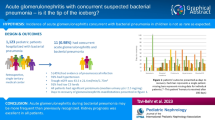Abstract
Objectives
To evaluate the clinical characteristics, complications and outcome of post-infectious glomerulonephritis (PIGN).
Methods
This prospective observational study was conducted from January 2013 through July 2014 at a tertiary care hospital in south India. Post-streptococcal glomerulonephritis (PSGN) was diagnosed in the presence of: a) Hematuria and proteinuria b) Clinico-serological evidence of recent streptococcal infection [recent pyodermas or pharyngitis; positive antistreptolysin-O (ASO) titres, anti-DNAse B titres or throat swab positivity for Group A streptococcus], and c) Low serum C3 levels, with normalization on 8 wk follow up. PIGN included PSGN and other infectious etiologies. AKI was classified as per Acute Kidney Injury Network (AKIN) criteria. Clinical features, biochemical and serological investigations in the study subjects were recorded.
Results
Among 83 children with acute nephritic syndrome (ANS) recruited, 72 (86.7 %) had PIGN. PSGN was the most common etiology [65(90.3 %)] among the PIGN cases. Pyodermas, upper respiratory infections and varicella preceded hematuria in 58 (80.6 %), 4 (5.6 %) and 2 (2.8 %) cases respectively. Pneumonia, mumps and liver abscess caused PIGN in 7 (9.7 %) cases. Complications included AKI in 15 (20.8 %), hypertensive emergency in 14 (19.4 %), cardiac failure in 8 (11.1 %), encephalopathy in 3 (4.2 %) cases and retinopathy in 1 (1.4 %) case. Among the AKI patients, 3(20 %) were in AKI stage 3, while 1 child required hemodialysis. Twenty three cases (31.9 %) had evidence of residual renal injury at discharge. Renal biopsy showed diffuse proliferative glomerulonephritis in 4 and crescentic glomerulonephritis in one case of PIGN. At 6 mo follow up, one patient continued to have microalbuminuria.
Conclusions
PIGN (including PSGN) remains a significant contributor to morbidity in children with ANS. The study is notable for high incidence of hypertensive emergency and AKI, that often required intensive care management.

Similar content being viewed by others
References
Eison TM, Ault BH, Jones DP, Chesney RW, Wyatt RJ. Post-streptococcal acute glomerulonephritis in children: clinical features and pathogenesis. Pediatr Nephrol. 2011;26:165–80.
Srivastava T, Warady, Alon US. Pneumonia-associated acute glomerulonephritis. Clin Nephrol. 2002;57:175–82.
DeFranco PE, Shook LA, Goebel J, Lee B. Solitary hepatic abscess with associated glomerulonephritis in a neonate. J Perinatol. 2000;20:384–6.
Zaki SA, Shanbag P, Bhongade S. Acute glomerulonephritis following varicella infection. Indian J Nephrol. 2012;22:64.
Bhagat M, Zaki SA, Sharma S, Manglani MV. Acute glomerulonephritis in dengue haemorrhagic fever in the absence of shock, sepsis, haemolysis or rhabdomyolysis. Paediatr Int Child Health. 2012;32:161–3.
Vijayakumar M. Acute and crescentic glomerulonephritis. Indian J Pediatr. 2002;69:1071–5.
Sarkissian A, Papazian M, Azatian G, Arikiants N, Babloyan A, Leumann E. An epidemic of acute postinfectious glomerulonephritis in Armenia. Arch Dis Child. 1997;77:342–4.
National High Blood Pressure Education Program Working Group on High Blood Pressure in Children and Adolescents. The fourth report on the diagnosis, evaluation, and treatment of high blood pressure in children and adolescents. Pediatrics. 2004;114:555–76.
Mehta RL, Kellum JA, Shah SV, et al. Acute kidney injury network: report of an initiative to improve outcomes in acute kidney injury. Crit Care. 2007;11:R31.
Ceriotti F, Boyd JC, Klein G, et al. Reference intervals for serum creatinine concentrations: assessment of available data for global application. Clin Chem. 2008;54:559–66.
Pan CG, Avner ED. Acute poststreptococcal glomerulonephritis. In: Kliegman RM, Stanton BM, St. Geme J, Schor N, Behrman RE, editors. Nelson’s textbook of pediatrics. Philadelphia: Elsevier Saunders; 2011. p. 1783.
Leung DT, Tseng RY, Go SH, French GL, Lam CW. Post-streptococcal glomerulonephritis in Hong Kong. Arch Dis Child. 1987;62:1075–6.
Bisno AL, Stevens DL. Streptococcus pyogenes. In: Mandell GL, Bennett JE, Dolin R, editors. Mandell, Douglas, and Bennett’s Principles and Practice of Infectious Diseases. Philadelphia: Elsevier; 2009. p. 198.
Low DE. Nonpneumococcal streptococcal infections, rheumatic fever. In: Goldman L, Schafer A, editors. Goldman’s Cecil Medicine. Philadelphia: Elsevier Saunders; 2011. p. 298.
Bingler MA, Ellis D, Moritz ML. Acute post-streptococcal glomerulonephritis in a 14-month-old boy: why is this uncommon? Pediatr Nephrol. 2007;22:448–50.
Rajajee S. Post-streptococcal acute glomerulonephritis: a clinical, bacteriological and serological study. Indian J Pediatr. 1990;57:775–80.
Wong W, Morris MC, Zwi J. Outcome of severe acute post-streptococcal glomerulonephritis in New Zealand children. Pediatr Nephrol. 2009;24:1021–6.
El-Husseini AA, Sheashaa HA, Sabry AA, Moustafa FE, Sobh MA. Acute postinfectious crescentic glomerulonephritis: clinicopathologic presentation and risk factors. Int Urol Nephrol. 2005;37:603–9.
Becquet O, Pasche J, Gatti H, et al. Acute post-streptococcal glomerulonephritis in children of French Polynesia: a 3-year retrospective study. Pediatr Nephrol. 2010;25:275–80.
Askenazi DJ, Feig DI, Graham NM, Hui-Stickle S, Goldstein SL. 3-5 year longitudinal follow-up of pediatric patients after acute renal failure. Kidney Int. 2006;69:184–9.
Contributions
KG, SK and SM were involved in management of the patients. KG collected the data, reviewed the literature and drafted the manuscript. SK conceptualized the study, reviewed the literature and critically reviewed the manuscript. SM critically revised the manuscript. BNH supervised the laboratory tests. APK performed the statistical analysis. All authors contributed to writing the paper and approved the final version of the manuscript. SK shall act as guarantor of the paper.
Conflict of Interest
None.
Source of Funding
The study was supported by an intramural grant from the authors’ institution for estimation of serum anti-DNAse B and C3 levels, which is gratefully acknowledged.
Author information
Authors and Affiliations
Corresponding author
Rights and permissions
About this article
Cite this article
Gunasekaran, K., Krishnamurthy, S., Mahadevan, S. et al. Clinical Characteristics and Outcome of Post-Infectious Glomerulonephritis in Children in Southern India: A Prospective Study. Indian J Pediatr 82, 896–903 (2015). https://doi.org/10.1007/s12098-015-1752-0
Received:
Accepted:
Published:
Issue Date:
DOI: https://doi.org/10.1007/s12098-015-1752-0




